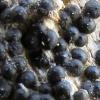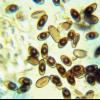
13-12-2012 18:39
Roland LabbéBonjour ! Voici un Xylariaceae ? inconnu.Les spore

18-12-2012 19:13
Esquivel-Rios EduardoHi All.Here a Nectriaceae (?) in dead wood found i

13-12-2012 18:15
Hola a todos:Os presento un ejemplar que supongo C

06-12-2012 21:37
 Gilles Corriol
Gilles Corriol
Bonjour à tous,Voici une récolte pour laquelle j

14-12-2012 21:32
Salvador TelloDe 0,2 mm, en madera seca de Ficus caria, pelos se
Nemania ou Rosellinia ?
Roland Labbé,
13-12-2012 18:39
Voici un Xylariaceae ? inconnu.
Les spores mesurent (13,5)14-16,5 x 6,5-8 µm.
J'aimerais uniquement savoir s'il est possible de situer ces spécimens dans un genre.
Merci et amitiés !
Roland
Jacques Fournier,
13-12-2012 18:47

Re : Nemania ou Rosellinia
un petit effort, Roland!
Ce que tu nous poses c'est une devinette, pas une question
Amitiés,
Jacques
Ce que tu nous poses c'est une devinette, pas une question
Amitiés,
Jacques
M Jonathan,
13-12-2012 19:02
Re : Nemania ou Rosellinia
Roland, j'ai déja les donnée micro, pourquoi ne pas les placer également ainsi que les dimensions obtenue?
Yannick Mourgues,
14-12-2012 00:22

Re : Nemania ou Rosellinia ?
Une aide : http://pyrenomycetes.free.fr/rosellinia/keydir/dichotomickey.htm? ...
Yannick Mourgues,
19-12-2012 18:31

Re : Nemania ou Rosellinia ?
Alors ? (Rosellinia) A qui la faute ?
Yannick
Yannick

